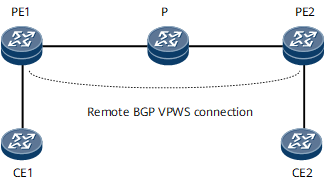If two CEs connect to different PEs, you can create a remote BGP VPWS connection for the two CEs to communicate.
Context
On the network shown in Figure 1, CE1 and CE2 connect to different PEs. A remote BGP VPWS connection needs to be established between PE1 and PE2 for the two CEs to communicate.
Figure 1 Configuring a remote BGP VPWS connection
Procedure
- Enable MPLS L2VPN.
- Run system-view
The system view is displayed.
- Run mpls l2vpn
MPLS L2VPN is enabled.
- Run quit
Return to the system view.
- Configure PEs to exchange VPWS information as BGP peers.
- Run bgp as-number
The BGP view is displayed.
- Run peer ipv4-address as-number peer-as
A BGP peer and its AS number are specified.
- Run peer ipv4-address connect-interface interface-type interface-number
The source interface for sending BGP packets is specified.
- Run l2vpn-ad-family
The L2VPN-AD address family view is displayed.
- (Optional) Run vpn-orf enable
The ORF is enabled.
- Run peer ipv4-address enable
The route exchange capability is enabled.
- Run signaling vpws or peer ip-address signaling vpws
BGP VPWS is enabled.
- Run quit
Return to the BGP view.
- Run quit
Return to the system view.
- Configure a remote BGP VPWS connection.
- Run mpls l2vpn l2vpn-name [ encapsulation { ethernet | vlan | ip-interworking | ip-layer2 } ] [ control-word | no-control-word ]
A BGP VPWS instance is created, and the MPLS-L2VPN instance view is displayed.
If heterogeneous interworking is required, specify ethernet | vlan | ip-interworking | ip-layer2 as ip-interworking for successful PW establishment.
- Run route-distinguisher route-distinguisher
An RD is configured for the L2VPN instance.
- (Optional) Run mtu mtu-value
An MTU is configured for the L2VPN instance.
The MTU size determines the maximum packet size allowed by a VPWS network. If the MTU exceeds the maximum packet size allowed by a VPWS network or an intermediate node (P), packet fragmentation or even drop will occur, affecting network transmission. The MTU is one of the VPWS negotiation parameters. If the MTUs of the same L2VPN instance on the endpoint PEs are different, the two PEs cannot exchange reachability information or establish a PW. An appropriate MTU must be set for an L2VPN instance based on the MTU of the interface bound to the L2VPN instance. Specifically, the MTU of an L2VPN instance must be less than or equal to the MTU of the interface bound to the L2VPN instance.
- (Optional) Run ignore-mtu-match
The current device is configured not to perform the MTU match check.
If the MTUs of the same L2VPN instance on the two endpoint PEs do not match, the VC cannot go Up. If some devices do not support the MTU match check, run the ignore-mtu-match command to disable this check.
- Run vpn-target { vpn-target } & <1-16> [ both | export-extcommunity | import-extcommunity ]
VPN targets are configured.
- Run ce ce-Name [ id ce-id [ range ce-range ] [ default-offset ce-offset ] ]
A CE is created in the L2VPN instance.
- Run connection [ ce-offset ce-offset-id ] interface interface-type interface-number [ tunnel-policy tunnel-policy-name ] [ raw | tagged ] [ secondary ]
A remote BGP VPWS connection is configured.
- Run commit
The configuration is committed.
